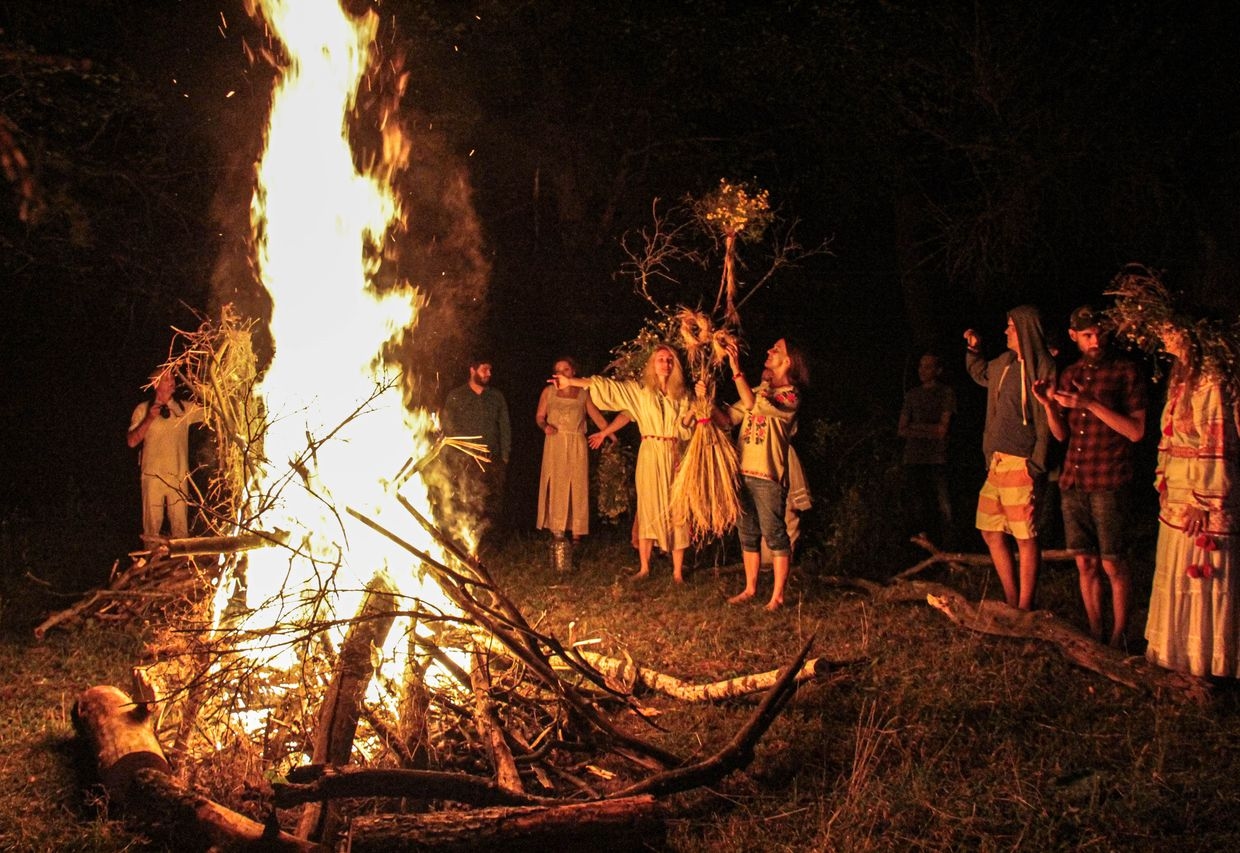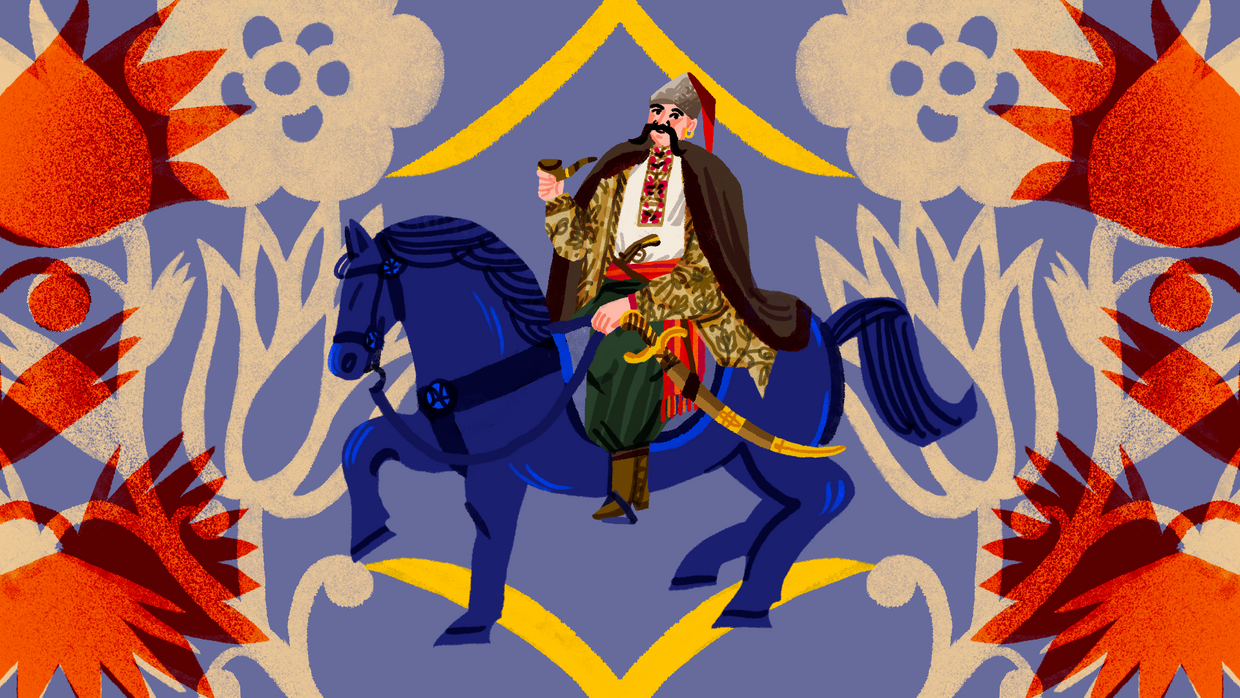Ivana Kupala is a traditional Ukrainian midsummer festival, with origins in ancient pagan rituals honoring the summer solstice and the god Kupalo, linked to fire, water, and fertility. (Albina Kolesnichenko)
As the day begins in late June, people collect flowers and herbs from meadows and riverbanks, fashioning them into wreaths. They craft effigies out of willow and straw of the ancient deities Kupalo and Mara, setting the stage for a nighttime ritual that honors the elemental forces of fire and water.
As evening falls, a great bonfire is lit near the riverbank. Pairs or small groups leap over its flames with clasped hands. The effigies are ceremonially burned or drowned, and candle-lit wreaths are set to float down the river. The night culminates in the search for the mythical fern flower as pairs venture off to explore the mysteries of the night together.

These vibrant and enchanting traditions mark the celebration of Ivana Kupala that falls on June 24 (Julian calendar) or July 7 (Gregorian calendar). It's a cherished and ancient holiday that has long been a significant part of Ukrainian culture, particularly in western and central parts of Ukraine, where the traditional rituals and festivities are more robustly observed.
Kupalo, the pagan god of earthly fruits, is associated with fertility, harvests, and the summer solstice in Slavic mythology. Ivana Kupala's celebration, rooted in ancient pagan traditions, honors fire, water, and vegetation through rituals seeking purification, protection, health, fertility, and a bountiful harvest. The name "Kupala," derived from "kupaty" (to bathe), reflects the water purification rituals central to the holiday.
Where did Ivana Kupala come from?
Written references to the tradition date back to the 11th century, though its origins are much older.
The festival's timing was marked on a fourth-century calendar pot found in the Middle Dnipro River region. The term “Kupalo” first appeared in historical records in 1262. Descriptions of the festivities can also be found in various medieval and early-modern church documents.
Kupala has been celebrated for centuries to mark the summer solstice, which divides the year into two halves, with longer days before Kupala and shorter days afterward.
In ancient Ukraine, as in most agricultural societies, people believed in deities who contributed to a bountiful harvest. Ethnologist Nataliya Gromova explains that the rituals and traditions around the entire calendar year were enacted because people believed the harvest would not occur without magical interference. They believed that plants would not grow by themselves without these rituals.
The Christian church tried to suppress the Ivana Kupala tradition during the spread of Christianity in Eastern Europe, particularly from the 10th century onward. This effort aimed to replace pagan customs with Christian practices. The church's influence led to the partial Christianization of the holiday by adding the prefix "Ivan," in reference to St. John the Baptist, whose feast day is celebrated on June 24 (Julian calendar) or July 7 (Gregorian calendar). This blending of traditions is why the holiday is now referred to as “Ivana Kupala.”
Despite Russia's full-scale invasion and the suspension of public Kupala celebrations since 2022 due to curfew, Ukrainians in smaller villages and the far western regions, hundreds of kilometers away from the front line, continue to celebrate.
These regions often have close-knit communities that honor cultural heritage, finding ways to adapt the celebrations to current circumstances, such as holding smaller, more private gatherings and observing rituals in a more subdued manner to avoid attracting attention. This persistence underscores the deep-rooted significance of Ivana Kupala in Ukrainian culture.
What do the Ivana Kupala rituals mean?
Kupala was a special day for honoring plants. Ferns, burdocks, periwinkle, stinging nettle, prickly thistle, sweet clover, tarragon, and other seasonal blooms are among those collected.
Some of the greenery and wildflowers are used to adorn women’s hair with a “vinok” (wreath or garland), which can include buttercups, daisies, baby’s breath, cornflowers, poppies, violets, chamomile, eucalyptus, yarrow and more.

Once dark, the herb and flower wreaths are sent adrift down the river, each adorned with a candle. Traditionally, unmarried women would interpret the fate of their love lives based on the wreaths' paths: a floating wreath foretold of impending marriage, while a sinking one suggested a delay.
In traditional Slavic customs, young men would attempt to retrieve the wreaths from the water to capture a woman's interest. This gesture was part of the festive atmosphere, highlighting rituals of fertility and courtship. It was a time when young men could display bravery and express their romantic intentions during social mingling and matchmaking rituals of the celebration.
Effigies are also crafted out of willow and straw, representing Kupalo and Mara. In Slavic mythology, Mara is associated with winter, death, and the underworld. She is often depicted as a goddess who brings about the end of winter and the beginning of spring, symbolizing the cycle of life, death, and rebirth.
The drowning and burning of these effigies symbolize offerings to the sun and water deities in exchange for blessings for a bountiful harvest. Each ritual at night signifies the union of the opposites – masculine (fire) and feminine (water) – aiming to ensure health, fertility, and reproduction. Originating in antiquity (before the fourth century AD), Kupala marked the start of the mating season, epitomizing the blend of these energies, as seen in the mythical union of Kupalo and Mara.

A giant bonfire is usually lit near a riverbank, again symbolizing this friendship between water and fire. Attendees contribute items like straw, old clothes, and wooden pieces to feed the flames, representing the burning away of impurities. Traditionally, a woman ignites the fire, symbolizing fertility, and people dance around the flames throughout the night. The bonfires were also believed to guide livestock home for protection and were used in healing rituals, such as burning the shirt of a sick child.
In pairs, participants will leap over the fire together. If they successfully complete three jumps without touching the flames or breaking hold of each other’s hands, it was believed they will marry, leading to a prosperous and healthy life. Sometimes wormwood was cast into the fire to fulfill wishes, while sage, mullein, and mugwort were added to the hot coals afterwards to dispel negative energies from the surroundings. Ashes from the Kupala bonfire were sometimes collected and sprinkled in one’s yard and garden to bring health and fertility.

On Kupala night, water was believed to have purification and healing powers. According to ethnologist Nataliya Gromova, in some villages, it was believed that bathing when the sun was at the same level as the water would bring purification. In some areas, people would wash their faces with the morning dew, similar to the Beltane ritual of the Celts for beauty and longevity.
The celebration also includes a ceremonial feast, featuring traditional dishes like kvass (a fermented beverage), porridge, and sweet dumplings, or varenyky.
Varying from region to region, Kupala night includes practices such as singing ancient songs, dream interpretation, and divination.
There were also superstitions associated with Kupala. Sleeping was discouraged due to the heightened activity of evil spirits like witches and house spirits.
Seeing a snake portended trouble, while a starry sky foretold a plentiful harvest. Borrowing or lending money was cautioned against to avoid jeopardizing prosperity. In some regions, bathing in water was strictly prohibited, as it was thought the water could transport a person to another dimension. Pregnant women and young men were advised to avoid water to prevent potential dangers from Rusalky (water nymphs) who might drag them to the bottom.

Arguably the most captivating ritual of the night is the hunt for the mythical fern flower, often referred to as “the magical fiery flower of happiness,” which only blossoms on Kupala night. Traditionally searched for in pairs, it is considered an almost unattainable prize due to the forest demons guarding it. Whoever manages to find it is believed to receive the gift of insight into the future and the ability to understand the language of animals.
It was also believed that discovering the fern flower would grant health and wealth, the ability to cure any disease, the powers of invisibility, and the ability to see where treasures are buried in the ground.
The pursuit of the fern flower also served as a subtle method to encourage young people to venture into the woods alone. This fertility festival historically permitted couples to engage in relationships outside of marriage without societal disapproval.


















